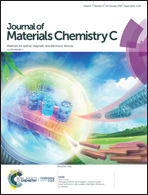A molecular ferroelectrics induced electroactive β-phase in solution processed PVDF films for flexible piezoelectric sensors†
Abstract
Piezoelectric polymers such as poly(vinylidene fluoride) (PVDF) have attracted great interest for applications in flexible sensors and wearable electronic devices. A high content of the electroactive β-phase in PVDF is one of the prerequisites for achieving excellent piezoresponse and sensing. In this work, composite films with high content of the β-phase in a PVDF matrix were prepared by blending a molecular ferroelectric with multiple polarization axes (dabcoHReO4) with PVDF. An obvious change from the α-phase to the β-phase in PVDF was achieved by exploring the hydrogen bonding interaction between the PVDF matrix and dabcoHReO4 fillers and evidenced by the FT-IR and XRD results. We found that the β-phase content in the composite materials depended on the content of dabcoHReO4, in which 8 wt% of dabcoHReO4 enabled induction and stabilization of the β-phase content up to 95%. In addition, the composite films prepared by simple solution processes exhibited excellent ferroelectric and piezoelectric properties, evidenced by ferroelectric hysteresis loops and piezoelectric vibration tests. These results indicate that the dabcoHReO4–PVDF composite materials can be potentially used in flexible sensing electronics and next-generation electronics.



 Please wait while we load your content...
Please wait while we load your content...